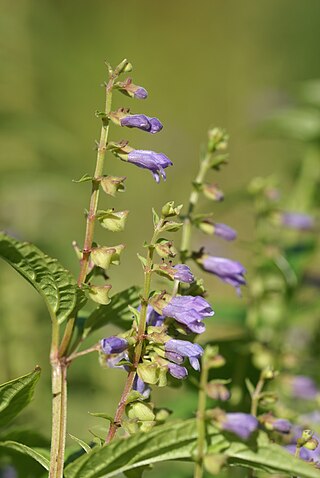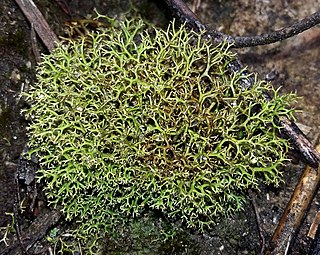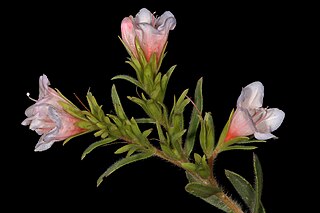
Petrosaviaceae is a family of flowering plants belonging to a monotypic order, Petrosaviales. Petrosaviales are monocots, and are grouped within the lilioid monocots. Petrosaviales are a very small order of photosynthetic (Japonolirion) and rare leafless achlorophyllous, mycoheterotrophic plants (Petrosavia) found in dark montane rainforests in Japan, China, Southeast Asia and Borneo. They are characterised by having bracteate racemes, pedicellate flowers, six persistent tepals, septal nectaries, three almost distinct carpels, simultaneous microsporogenesis, monosulcate pollen, and follicular fruit.

The yacón is a species of perennial daisy traditionally grown in the northern and central Andes from Colombia to northern Argentina for its crisp, sweet-tasting, tuberous roots. Their texture and flavour are very similar to jícama, mainly differing in that yacón has some slightly sweet, resinous, and floral undertones to its flavour, probably due to the presence of inulin, which produces the sweet taste of the roots of elecampane, as well. Another name for yacón is Peruvian ground apple, possibly from the French name of potato, pomme de terre. The tuber is composed mostly of water and fructooligosaccharide.
Harold Ernest Robinson was an American botanist and entomologist.

Diplazium esculentum, the vegetable fern, is an edible fern found throughout Asia and Oceania. It is probably the most commonly consumed fern.

The Baker–Venkataraman rearrangement is the chemical reaction of 2-acetoxyacetophenones with base to form 1,3-diketones.

Apigenin (4′,5,7-trihydroxyflavone), found in many plants, is a natural product belonging to the flavone class that is the aglycone of several naturally occurring glycosides. It is a yellow crystalline solid that has been used to dye wool.

Flavones are a class of flavonoids based on the backbone of 2-phenylchromen-4-one (2-phenyl-1-benzopyran-4-one).

Scutellaria lateriflora, is a hardy perennial herb of the mint family, Lamiaceae, native to North America.

As baicalin is a flavone glycoside, it is a flavonoid. It is the glucuronide of baicalein.

Eupatilin (5,7-Dihydroxy-3',4',6-trimethoxyflavone) is an O-methylated flavone, a type of flavonoids. It can be found in Artemisia asiatica (Asteraceae).

Pieter B. Pelser is a lecturer in Plant Systematics and the curator of the herbarium at the University of Canterbury in Christchurch, New Zealand. One research interest is the evolutionary history of the tribe Senecioneae, one of the largest tribes in the largest family of flowering plants. He wrote the most recent attempt to define and delimit this tribe and its problematic founding species Senecio. He also studies insects that eat these plants (Longitarsus) which contain pyrrolizidine alkaloids and what makes them choose which plants they eat.

Baicalein (5,6,7-trihydroxyflavone) is a flavone, a type of flavonoid, originally isolated from the roots of Scutellaria baicalensis and Scutellaria lateriflora. It is also reported in Oroxylum indicum and Thyme. It is the aglycone of baicalin. Baicalein is one of the active ingredients of Sho-Saiko-To, which is a Chinese classic herbal formula, and listed in Japan as Kampo medicine. As a Chinese herbal supplement, it is believed to enhance liver health.

Cladia is a genus of lichenized fungi in the family Cladoniaceae. Cladia species have a crustose primary thallus and a fruticose, secondary thallus, often referred to as pseudopodetium. The type species of the genus, Cladia aggregata, is widely distributed, occurring from South America, South Africa, Australasia and South-East Asia to southern Japan and India. Most of the other species are found in the Southern Hemisphere.

Smallanthus is a genus of flowering plants in the tribe Millerieae within the family Asteraceae.
Lophopappus is a genus of South American flowering plants in the family Asteraceae.

Centaureidin is an O-methylated flavonol. It can be isolated from Tanacetum microphyllum, Achillea millefolium, Brickellia veronicaefolia, Bidens pilosa and Polymnia fruticosa.

Nepetin is the 6-Methoxy derivative of the pentahydroxyflavone 6-Hydroxyluteolin, an O-methylated flavone. It can be found in Eupatorium ballotaefolium.

Pteris ensiformis, the slender brake, silver lace fern, sword brake fern, or slender brake fern, is a plant species of the genus Pteris in the family Pteridaceae. It is found in Asia and the Pacific.

Smallanthus uvedalia, known as hairy leafcup, bear's foot, and yellow flower leafcup, is a herbaceous perennial native to the Central and Eastern United States. It is a member of the family Asteraceae.

Lobostemon fruticosus, also known as the eightday healthbush or pyjamabush, is a species of medicinal plant from South Africa. It is considered to be ecologically and economically important but is declining due to overexploitation.

















